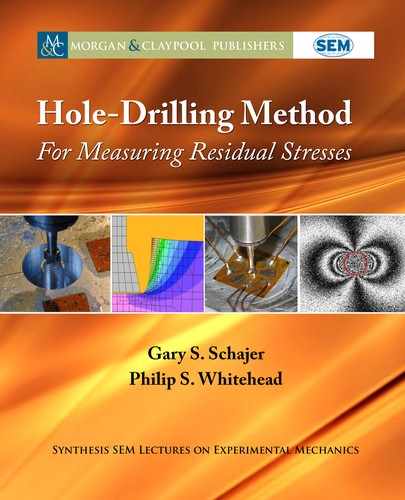2.13. IMPACT OF MODERN MEASUREMENT TECHNOLOGIES 37
Figure 2.11 schematically illustrates a typical Sectioning Method measurement. In this
example, the sequence of cuts used resembles a combination of the Excision Method and the
Layer Removal Method. A feature of the Sectioning Method is that the surfaces created by the
cuts made in one step are available for use as measurement locations in subsequent steps. As can
be seen in the example procedure, the Sectioning Method is highly destructive and typically the
specimen is reduced to a large number of small pieces. However, the large amount of cutting
allows for residual stress measurements to be made at multiple points of interest within the
original specimen.
Residual stress computations for the Sectioning Method can often be challenging because
each successive cut partially relieves the local residual stresses, leaving an altered residual stress
state to be relieved further by subsequent cuts. us, the residual stress computation procedure
has to keep track of this sequence so that the final results relate back to the originally existing
residual stresses. is is not an easy task and has to be done with significant care. If done well, the
Sectioning Method is a very flexible, if rather labor-intensive, method for measuring detailed
residual stresses in a broad range of specimens.
2.13 IMPACT OF MODERN MEASUREMENT
TECHNOLOGIES
Most of the residual stress measurement methods described in this chapter are long established
with substantial histories. ey can be implemented using various experimental techniques,
chosen according to desired features. Over the years, as technology has advanced, the variety
and functionalities of experimental techniques have greatly increased both in terms of proce-
dural capability and precision. Such is the scale of these advances that the modern residual
stress measurement procedures are essentially “new” methods when compared with the early
versions. Modern computer-based computation methods have similarly revolutionized residual
stress computation capabilities, allowing stress evaluations that were far beyond reach in earlier
times. Figure 2.12 illustrates examples of both of these advances. e figure shows relaxation
measurements made using various of the techniques described in this chapter, but done at the
microscopic scale. e “cuts” shown in the images are made using a Focused Ion Beam within a
Scanning Electron Microscope (FIB-SEM). e cut features are less than 0.5 m wide, while
the whole image width spans 15 m. ese are very small dimensions, the first equals the wave-
length of visible (green) light, while the second is about one-fifth the diameter of a human hair.
Measurements on this scale are useful for studying residual stresses within integrated circuits,
MEMS devices and within individual crystal grains in metals.
e speckled background within the images in Figure 2.12 is a random dot pattern delib-
erately “decorated” onto the specimen surface by ion deposition. ese speckles provide the basis
for Digital Image Correlation (DIC) evaluation of the surface deformations caused by the vari-
ous cuts into the stressed surfaces. e use of DIC in this way provides a very effective method
for measuring surface displacements, even at this microscopic scale. Such DIC measurements
..................Content has been hidden....................
You can't read the all page of ebook, please click here login for view all page.
